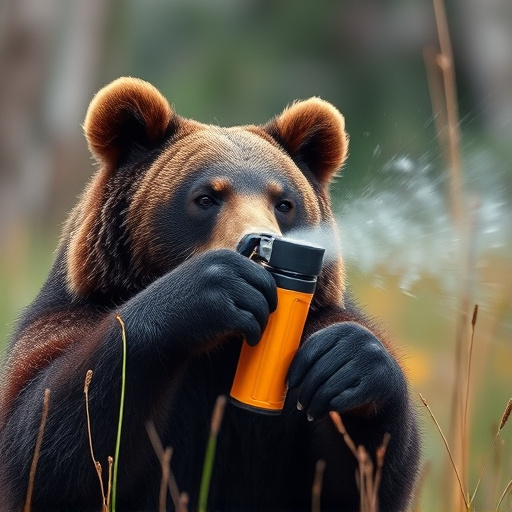Understanding bear spray residue distribution is key to assessing its effectiveness as a deterrent. Residue lingers in air 15-30 seconds, affecting bear behavior and health. Distance, wind, product specifics, and environmental factors impact range. Higher capsaicin concentrations offer longer protection, up to several yards. Proper usage techniques include strategic deployment, making oneself appear larger, yelling, and zigzag application from 20-30 feet away. Continuous spraying until bear retreats ensures residual effects for hours with minimal harm. Bear spray successfully reduces wildlife impact and human-bear conflicts in regions with black bear populations.
In bear country, understanding the effectiveness of bear spray is crucial for safety. This guide explores how bear spray residue spreads and its impact on wildlife, delving into factors influencing deterrence range. We analyze real-world case studies and best practices to ensure optimal use. Discover key insights into what works best in mitigating potential conflicts between humans and bears, with a focus on minimizing Bear Spray Residue’s ecological Wildlife Impact.
- Understanding Bear Spray Residue Distribution
- Wildlife Exposure and Potential Impacts
- Factors Affecting Deterrent Range Effectiveness
- Case Studies: Real-World Application Successes
- Best Practices for Optimal Bear Spray Use
Understanding Bear Spray Residue Distribution
Understanding how bear spray residue is distributed is crucial in assessing its effectiveness as a deterrent. When a bear spray is deployed, it creates a cloud of aerosolized chemicals that can travel varying distances, depending on several factors such as wind speed and direction, terrain, and the specific product used. Research indicates that bear spray residue typically lingers in the air for approximately 15-30 seconds before settling onto surfaces nearby.
The impact of this residue on wildlife, particularly bears, is a subject of interest. While bear spray is designed to temporarily incapacitate bears and provide an escape route, the long-term effects of its residue on their behavior and health are not fully understood. Studies suggest that bears may exhibit avoidance behaviors after coming into contact with bear spray residue, but more research is needed to determine the potential cumulative impacts on wild populations.
Wildlife Exposure and Potential Impacts
Wildlife exposure to bear spray, especially residue left behind after application, can have significant impacts. Bears, being highly sensitive to scents, may experience respiratory distress due to the aerosolized chemicals. Ingestion of contaminated food or water sources can also lead to toxicological effects, as bears often have varying diets depending on seasonal availability.
The presence of bear spray residue in their habitat can alter behavior and affect their natural interactions with the environment. Chronic exposure might cause long-term health issues, making it crucial to understand the effective range and proper use of bear spray to minimize wildlife impact.
Factors Affecting Deterrent Range Effectiveness
The effectiveness of bear spray as a deterrent is influenced by several factors. One key element is the distance at which the spray is deployed. Bear spray residue can remain effective for varying ranges, typically between 20 to 30 feet (6 to 9 meters), but this can be reduced by wind and environmental conditions. The concentration of capsaicin, the active ingredient in bear spray, plays a crucial role in its impact on wildlife. Higher concentrations can provide longer-lasting protection, deterring bears from approaching up to several yards away.
Another factor is the bearing and behavior of the bear when sprayed. Direct spraying into the bear’s face or eyes can have a more immediate and powerful effect, potentially disabling the animal momentarily. However, bears with defensive or aggressive intentions might not be deterred by standard spray ranges, emphasizing the need for proper usage techniques. Environmental conditions like temperature and humidity can also affect spray residue persistence and dispersion, further influencing its overall effectiveness as a deterrent.
Case Studies: Real-World Application Successes
In numerous real-world applications, bear spray has proven to be an effective deterrent, significantly reducing wildlife impact and ensuring human safety. Case studies in areas known for bear populations show that strategic deployment of bear spray can create a buffer zone around campsites, trails, and residential areas, deterring bears from approaching too closely. For instance, in regions where black bears are prevalent, regular spraying of high-risk zones has led to a marked decrease in bear-human conflicts.
These success stories highlight the importance of proper usage and timing. Bear spray residue remains effective for several hours, providing crucial protection during peak activity times when bears are most active and prone to seeking food sources. By understanding the range and duration of bear spray residue, individuals and communities can better protect themselves and minimize negative impacts on wildlife, fostering a harmonious coexistence between humans and nature.
Best Practices for Optimal Bear Spray Use
Using bear spray effectively requires understanding best practices for optimal results. Firstly, always ensure your spray is up-to-date and has not expired. Check the label for the recommended usage date. Secondly, when encountering a bear, make yourself appear larger by raising your arms or jacket overhead. Yell loudly to deter the bear, but avoid direct eye contact which may be perceived as a challenge.
For maximum impact, spray in a zigzag pattern at the bear’s face and chest from about 20-30 feet (6-9 meters) away. Aim for continuous spraying until the bear flees or you are out of bear spray. Remember, bear spray residue can remain effective for several hours, but its impact on wildlife is minimal when used responsibly. Proper usage not only protects individuals in bear country but also minimizes the distress caused to these magnificent creatures.
Bear spray has proven to be an effective deterrent, but understanding its residue distribution and optimal use practices is key to maximizing its range. By examining wildlife exposure, considering environmental factors, and learning from case studies, we can enhance the safety of individuals in bear country. Proper application techniques and knowledge of bear behavior can significantly reduce potential impacts, ensuring a more secure outdoor experience.
